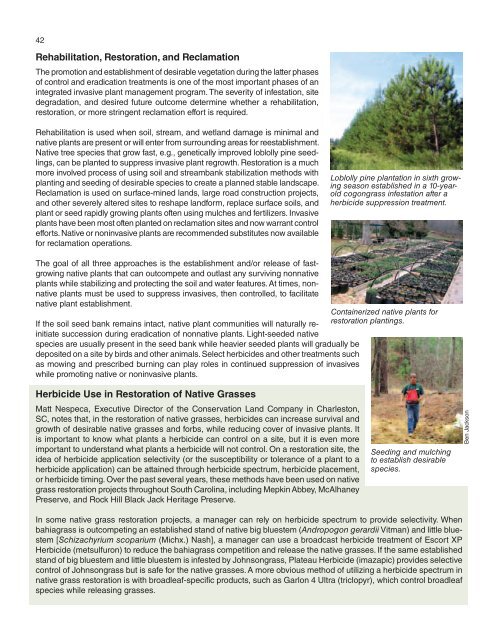A Management Guide for Invasive Plants in Southern Forests James ...
A Management Guide for Invasive Plants in Southern Forests James ...
A Management Guide for Invasive Plants in Southern Forests James ...
- No tags were found...
You also want an ePaper? Increase the reach of your titles
YUMPU automatically turns print PDFs into web optimized ePapers that Google loves.
42Rehabilitation, Restoration, and ReclamationThe promotion and establishment of desirable vegetation dur<strong>in</strong>g the latter phasesof control and eradication treatments is one of the most important phases of an<strong>in</strong>tegrated <strong>in</strong>vasive plant management program. The severity of <strong>in</strong>festation, sitedegradation, and desired future outcome determ<strong>in</strong>e whether a rehabilitation,restoration, or more str<strong>in</strong>gent reclamation ef<strong>for</strong>t is required.Rehabilitation is used when soil, stream, and wetland damage is m<strong>in</strong>imal andnative plants are present or will enter from surround<strong>in</strong>g areas <strong>for</strong> reestablishment.Native tree species that grow fast, e.g., genetically improved loblolly p<strong>in</strong>e seedl<strong>in</strong>gs,can be planted to suppress <strong>in</strong>vasive plant regrowth. Restoration is a muchmore <strong>in</strong>volved process of us<strong>in</strong>g soil and streambank stabilization methods withplant<strong>in</strong>g and seed<strong>in</strong>g of desirable species to create a planned stable landscape.Reclamation is used on surface-m<strong>in</strong>ed lands, large road construction projects,and other severely altered sites to reshape land<strong>for</strong>m, replace surface soils, andplant or seed rapidly grow<strong>in</strong>g plants often us<strong>in</strong>g mulches and fertilizers. <strong>Invasive</strong>plants have been most often planted on reclamation sites and now warrant controlef<strong>for</strong>ts. Native or non<strong>in</strong>vasive plants are recommended substitutes now available<strong>for</strong> reclamation operations.Loblolly p<strong>in</strong>e plantation <strong>in</strong> sixth grow<strong>in</strong>gseason established <strong>in</strong> a 10-yearoldcogongrass <strong>in</strong>festation after aherbicide suppression treatment.The goal of all three approaches is the establishment and/or release of fastgrow<strong>in</strong>gnative plants that can outcompete and outlast any surviv<strong>in</strong>g nonnativeplants while stabiliz<strong>in</strong>g and protect<strong>in</strong>g the soil and water features. At times, nonnativeplants must be used to suppress <strong>in</strong>vasives, then controlled, to facilitatenative plant establishment.If the soil seed bank rema<strong>in</strong>s <strong>in</strong>tact, native plant communities will naturally re<strong>in</strong>itiatesuccession dur<strong>in</strong>g eradication of nonnative plants. Light-seeded nativespecies are usually present <strong>in</strong> the seed bank while heavier seeded plants will gradually bedeposited on a site by birds and other animals. Select herbicides and other treatments suchas mow<strong>in</strong>g and prescribed burn<strong>in</strong>g can play roles <strong>in</strong> cont<strong>in</strong>ued suppression of <strong>in</strong>vasiveswhile promot<strong>in</strong>g native or non<strong>in</strong>vasive plants.Conta<strong>in</strong>erized native plants <strong>for</strong>restoration plant<strong>in</strong>gs.Herbicide Use <strong>in</strong> Restoration of Native GrassesMatt Nespeca, Executive Director of the Conservation Land Company <strong>in</strong> Charleston,SC, notes that, <strong>in</strong> the restoration of native grasses, herbicides can <strong>in</strong>crease survival andgrowth of desirable native grasses and <strong>for</strong>bs, while reduc<strong>in</strong>g cover of <strong>in</strong>vasive plants. Itis important to know what plants a herbicide can control on a site, but it is even moreimportant to understand what plants a herbicide will not control. On a restoration site, theidea of herbicide application selectivity (or the susceptibility or tolerance of a plant to aherbicide application) can be atta<strong>in</strong>ed through herbicide spectrum, herbicide placement,or herbicide tim<strong>in</strong>g. Over the past several years, these methods have been used on nativegrass restoration projects throughout South Carol<strong>in</strong>a, <strong>in</strong>clud<strong>in</strong>g Mepk<strong>in</strong> Abbey, McAlhaneyPreserve, and Rock Hill Black Jack Heritage Preserve.Seed<strong>in</strong>g and mulch<strong>in</strong>gto establish desirablespecies.Ben JacksonIn some native grass restoration projects, a manager can rely on herbicide spectrum to provide selectivity. Whenbahiagrass is outcompet<strong>in</strong>g an established stand of native big bluestem (Andropogon gerardii Vitman) and little bluestem[Schizachyrium scoparium (Michx.) Nash], a manager can use a broadcast herbicide treatment of Escort XPHerbicide (metsulfuron) to reduce the bahiagrass competition and release the native grasses. If the same establishedstand of big bluestem and little bluestem is <strong>in</strong>fested by Johnsongrass, Plateau Herbicide (imazapic) provides selectivecontrol of Johnsongrass but is safe <strong>for</strong> the native grasses. A more obvious method of utiliz<strong>in</strong>g a herbicide spectrum <strong>in</strong>native grass restoration is with broadleaf-specific products, such as Garlon 4 Ultra (triclopyr), which control broadleafspecies while releas<strong>in</strong>g grasses.
















